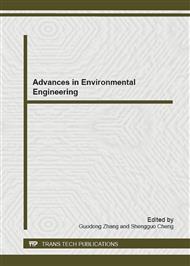p.578
p.582
p.586
p.592
p.598
p.602
p.608
p.614
p.618
Characteristics and Mechanisms of Cu (II) Biosorption on Sludge in the Presence of Citrate
Abstract:
The kinetics and thermodynamics of Cu(Ⅱ) biosorption on sludge in the presence of citrate were investigated. Biosorption mechanisms were characterized by biosorption characteristics and modern analysis means such as BET,FT-IR,XRD and SEM. The results show that the system of sludge and complexation of copper reaches equilibrium within 18h and the maximum removal rate of total copper is about 80%. Kinetic studies indicate that pseudo-second order model with correlation coefficients of 0.9959 best fits the biosorption process. The equilibrium of the system follows the Langmuir isotherm model. FT-IR spectral analysis indicates that amides, -OH, COO¯, silicate minerals, phosphate groups and polysaccharides serve as the main active groups. XRD and SEM analysis indicate the crystal shape of sludge changes and metal sediment can be found after biosorption. Adsorption mechanisms contain chelation, precipitation and ion-exchange.
Info:
Periodical:
Pages:
598-601
Citation:
Online since:
November 2012
Authors:
Keywords:
Price:
Сopyright:
© 2012 Trans Tech Publications Ltd. All Rights Reserved
Share:
Citation:


